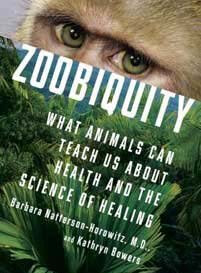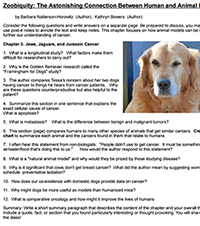
I try to read at least one non-fiction book per year to try to keep myself up to date and inspired with new knowledge and advances in medicine. I have a classroom set of “Stiff” that I require my AP Biology students to read during the unit on anatomy. Recently, in a graduate class (thanks to Joanne Manaster), I was required to read a chapter out of the book “Zoobiquity” by Barbera Natterson-Horowitz and Kathryn Bowers. I loved the chapter so much that I purchased the book and have required my own students to read the chapter.
Side note: Copying for education purposes generally falls under “Fair Use” as long as you do not copy more than 10% of the entire book and follow certain other guidelines.
Chapter 3, titled “Jews, Jaguars, and Jurassic Cancer” focuses on how cancers are present in all living things, not just humans. This provides a good starting point for talking about cell division and how any creature that has cells and grows is susceptible to errors in the machinery that copy DNA.
Students will enjoy the story of the golden retrievers who are providing samples and data to try to understand cancer in their species and how that information can then be extrapolated to humans. This golden retriever study has been called “Framingham for Dogs,” which references a long term study on heart disease in humans. The Framingham Heart Study that has yielded a wealth of information about how diet, exercise and medication correlate to heart disease. Students can read about both studies and discuss the merits and limitations of longitudinal studies.

There is also a section on dinosaurs and evidence that these giants may have also been afflicted with cancer, as evidenced in their fossil remains. Other animals are discussed in the chapter, comparing how humans and animals suffer from the same malignant cancers and what we can learn about cancers in other species that may benefit us. Treatments for cancers can sometimes be developed faster in animals as they are not subject to some of the same stringent requirements of human research.
I created this worksheet for students to complete as they read the chapter and we discuss a few of the main points in class as part of the unit on the cell cycle and inheritance. This is a way to connect a relatively dry lecture on mitosis with how cell division relates to a disease that everyone has some experience with.
Also, if you finish this chapter with your students, be sure to check out the chapter titled “The Koala and the Clap” which explores how pathogens exploit sexual reproduction to colonize new habitats. Humans aren’t the only ones who suffer from sexually transmitted disease.
Also, if you are not sure whether this book would interest you, you can actually read the the first chapter: “Dr. House, Meet Doctor Dolittle” as it has been reprinted with permission at WTTW Science and Technology.

